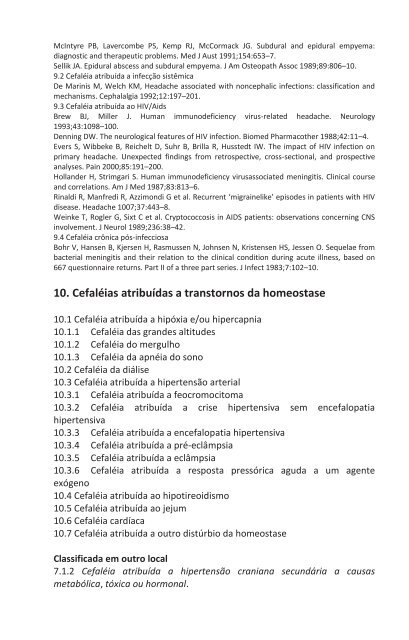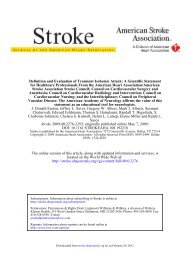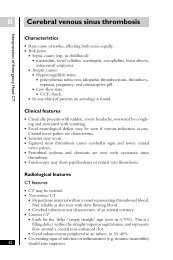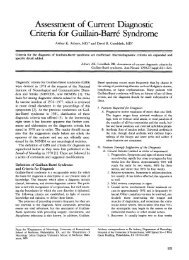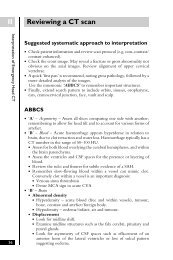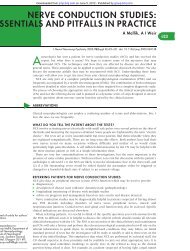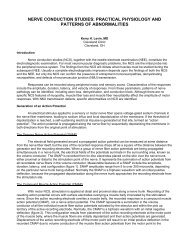Classificação Internacional das Cefaléias - HGF – Neurologia
Classificação Internacional das Cefaléias - HGF – Neurologia
Classificação Internacional das Cefaléias - HGF – Neurologia
Create successful ePaper yourself
Turn your PDF publications into a flip-book with our unique Google optimized e-Paper software.
McIntyre PB, Lavercombe PS, Kemp RJ, McCormack JG. Subdural and epidural empyema:<br />
diagnostic and therapeutic problems. Med J Aust 1991;154:653<strong>–</strong>7.<br />
Sellik JA. Epidural abscess and subdural empyema. J Am Osteopath Assoc 1989;89:806<strong>–</strong>10.<br />
9.2 Cefaléia atribuída a infecção sistêmica<br />
De Marinis M, Welch KM, Headache associated with noncephalic infections: classification and<br />
mechanisms. Cephalalgia 1992;12:197<strong>–</strong>201.<br />
9.3 Cefaléia atribuída ao HIV/Aids<br />
Brew BJ, Miller J. Human immunodeficiency virus-related headache. Neurology<br />
1993;43:1098<strong>–</strong>100.<br />
Denning DW. The neurological features of HIV infection. Biomed Pharmacother 1988;42:11<strong>–</strong>4.<br />
Evers S, Wibbeke B, Reichelt D, Suhr B, Brilla R, Husstedt IW. The impact of HIV infection on<br />
primary headache. Unexpected findings from retrospective, cross-sectional, and prospective<br />
analyses. Pain 2000;85:191<strong>–</strong>200.<br />
Hollander H, Strimgari S. Human immunodeficiency virusassociated meningitis. Clinical course<br />
and correlations. Am J Med 1987;83:813<strong>–</strong>6.<br />
Rinaldi R, Manfredi R, Azzimondi G et al. Recurrent ‘migrainelike’ episodes in patients with HIV<br />
disease. Headache 1007;37:443<strong>–</strong>8.<br />
Weinke T, Rogler G, Sixt C et al. Cryptococcosis in AIDS patients: observations concerning CNS<br />
involvement. J Neurol 1989;236:38<strong>–</strong>42.<br />
9.4 Cefaléia crônica pós-infecciosa<br />
Bohr V, Hansen B, Kjersen H, Rasmussen N, Johnsen N, Kristensen HS, Jessen O. Sequelae from<br />
bacterial meningitis and their relation to the clinical condition during acute illness, based on<br />
667 questionnaire returns. Part II of a three part series. J Infect 1983;7:102<strong>–</strong>10.<br />
10. <strong>Cefaléias</strong> atribuí<strong>das</strong> a transtornos da homeostase<br />
10.1 Cefaléia atribuída a hipóxia e/ou hipercapnia<br />
10.1.1 Cefaléia <strong>das</strong> grandes altitudes<br />
10.1.2 Cefaléia do mergulho<br />
10.1.3 Cefaléia da apnéia do sono<br />
10.2 Cefaléia da diálise<br />
10.3 Cefaléia atribuída a hipertensão arterial<br />
10.3.1 Cefaléia atribuída a feocromocitoma<br />
10.3.2 Cefaléia atribuída a crise hipertensiva sem encefalopatia<br />
hipertensiva<br />
10.3.3 Cefaléia atribuída a encefalopatia hipertensiva<br />
10.3.4 Cefaléia atribuída a pré-eclâmpsia<br />
10.3.5 Cefaléia atribuída a eclâmpsia<br />
10.3.6 Cefaléia atribuída a resposta pressórica aguda a um agente<br />
exógeno<br />
10.4 Cefaléia atribuída ao hipotireoidismo<br />
10.5 Cefaléia atribuída ao jejum<br />
10.6 Cefaléia cardíaca<br />
10.7 Cefaléia atribuída a outro distúrbio da homeostase<br />
Classificada em outro local<br />
7.1.2 Cefaléia atribuída a hipertensão craniana secundária a causas<br />
metabólica, tóxica ou hormonal.


